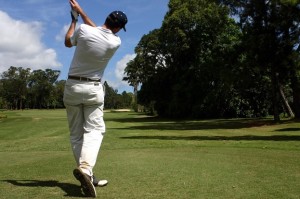Home on the Range: Effective Practice Techniques
There’s a common misconception among golfers. A lot of people go to the driving range and just power through a bucket of 100 balls. The idea is to develop muscle memory — the idea that you can simply train your muscles to swing correctly through repetition. This idea, however popular, has been disproved time and time again. In fact, it’s more likely that you’re just reinforcing bad habits with this kind of ineffective training. There are, however, some techniques that can make a day at the driving range a very effective way to perfect your swing and improve your game.
1. Stretch
It isn’t very exciting, but the first thing you should do when you get to the range is stretch. When your muscles are cold and tight, they won’t perform nearly as well. More importantly, you’re much more likely to injure yourself if you don’t stretch.
2. Focus on one aspect of your swing
There’s no point in just randomly smacking away at a bucket of balls. With each swing, you should be working on one particular aspect of your swing. Don’t get frustrated if it doesn’t work right away — it may take some time before it clicks and you see improvement.
3. Work through your bag
Start with your 9-iron and work your way down to the driver, then back up again. You can skip clubs, but you should avoid swinging the same club the whole time you’re at the range. This makes your practice more like a real game, where you use multiple clubs.
4. Chip and putt
Remember to spend some time working with your wedge and your putter before you leave the range. Most golfers spend very little time practicing the short game, but it’s critical to lowering your score.
a. Wedge – one of the easiest ways to practice perfecting distance control with a wedge is to change the angle of your backswing. Shorter backswing = shorter shot.
b. Putter – a great way to eliminate peeking is to push a tee all the way into the practice green and putting off of it. Make sure you don’t look at your shot until you see the tee.
5. Be consistent
It can be difficult to make time to practice regularly, but regular practice is critical to improving your golf game. There are a million excuses for not getting to the range, but you have to dedicate a certain amount of time to practice every week. That goes for the winter, as well. Even if playing at the course is impossible during the winter, there’s plenty of opportunity to work on your swing. There are exercises that you can do at home or at the office. You can work on your swing with a net in the garage, and you can work on your putt just about anywhere.
Golf simulators are also popping up everywhere. These are great because they give you real-time feedback on your performance, and many let you play a huge number of simulated courses from around the world.
With a few techniques and a little dedication, you can make real improvements in your game at the driving range. Of course, there’s a lot more to it than just whacking a bucket of balls and going home — you need to have a plan and you have to be patient. Stick with it — you’ll begin to see improvement soon enough.
Bio
Matt is an avid golf enthusiast and part of the TruGolf.com team. When he’s not working on his fairway shot, you will find Matt writing about his passion for the process of the game.
facebook.com/TruGolfSimulators


